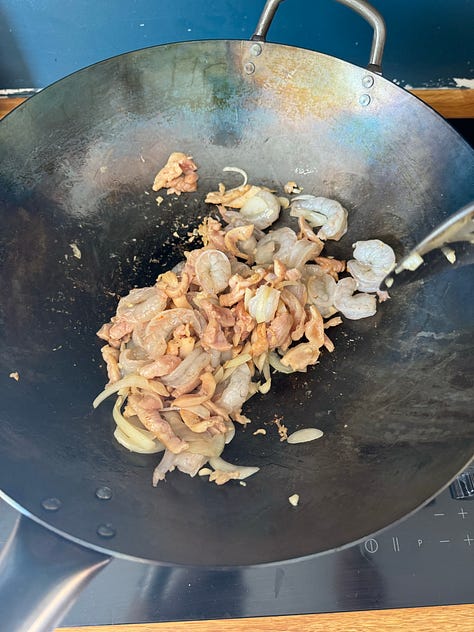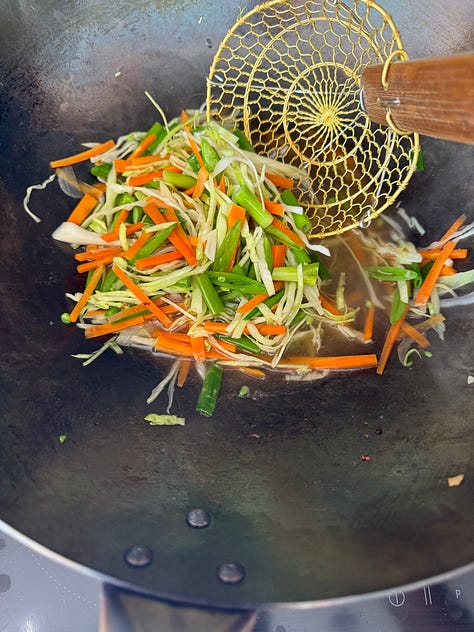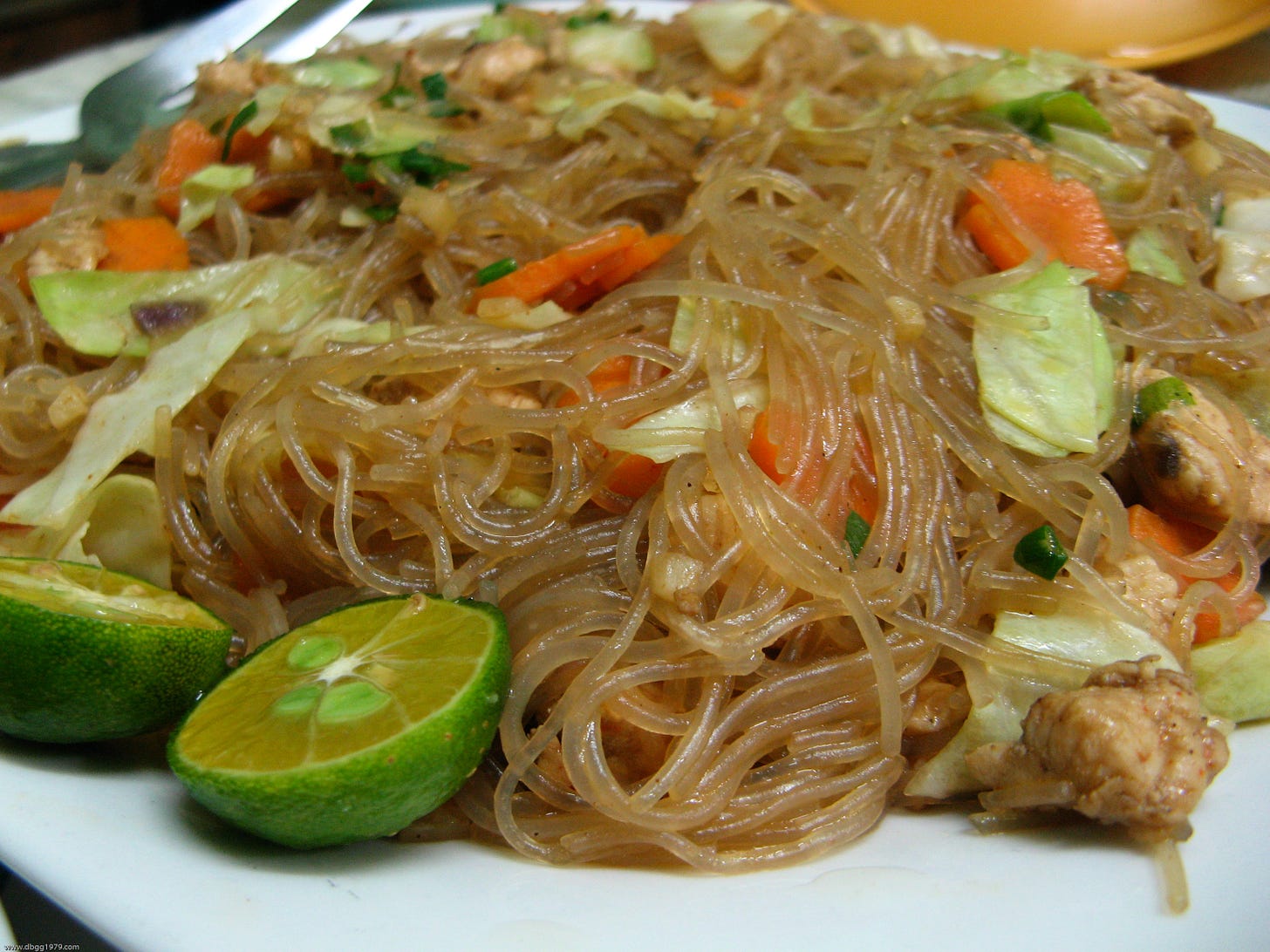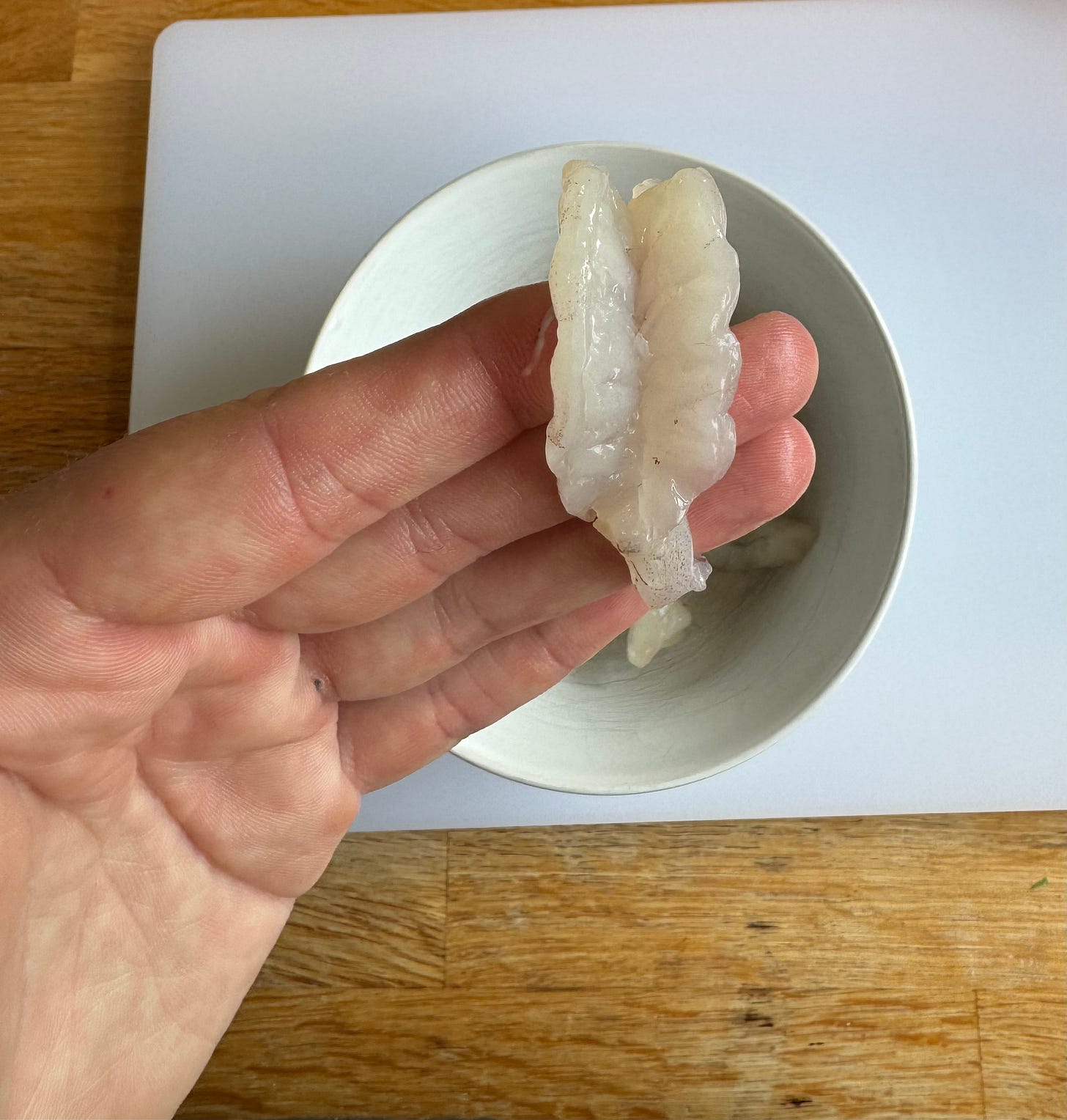As sure as night follows day, as certain as the sun rises, as inevitable as death and taxes, is pancit bihon at my family home on Christmas day. As far as my memory goes, pancit follows, for it has been a stalwart of every family celebration year after year. Essentially, it is little more than a basic Filipino noodle dish — rice vermicelli cooked in chicken stock with vegetables and an assortment of proteins. But it is more than that, too - it is nostalgia, family, and celebration; it is leftovers on Boxing Day; it is the delicious taste of mum's cooking.
I realise that most people who read this newsletter are not Filipino. And so I write it with you in mind. Why? My guess is that pancit is unfamiliar to you compared to the pad Thais, mee gorengs, chow funs, or drunken noodles of this world. My second guess is that if you were to try making pancit you'd like it. My third guess is that unlike so many of the dishes I make and write publicly about, pancit is relatively accessible and easy to make.
To add one more thing, pancit is nutritious and diverse; it isn't heavy and contains a liberal serving of vegetables with a bit of meat thrown in for good measure. And suppose I haven't sold it already. In that case, it's a dish that makes perfect leftovers - hanging out in the fridge for days, slowly depleting whilst — if you're anything like me — you continually heat up small amounts, snacking on it at odd times of the day, whilst gorging on it for breakfast, lunch and dinner.
So, through this lens, I want to share a recipe with everyone. Unlike most of the recipes I share, which are adaptations of foundational recipes I usually glean from reputable texts, this one here is based on my mum's recipe—the same one she's been using for years and years and years—it's a good'un, trust me.
But as is customary, a little background on pancit bihon and the wider class of dishes known as pancit.
Pancit
Pancit is a general term referring to a class of noodle dishes within Filipino cuisine. Etymologically speaking, pancit is Chinese, a derivative of the Hokkian phrase for 'convenient food'—reflecting the accessibility of the Chinese cooking methodology known as stir-frying. Historically, it is suggested that Indigenous Filipino ethnic groups were already accustomed to making noodles from local ingredients like mung beans and rice. Then, as Chinese settlers brought the tradition of stir-frying with them, pancit and its variations became a staple dish within the broader cuisine.
Pancit Bihon
Pancit bihon is a dish of thin rice vermicelli noodles cooked in chicken stock. An array of stir-fried vegetables and proteins are tossed through the noodles—typical choices include cabbage, carrots, bell peppers, snake beans, and snow peas for vegetables and prawns, chicken, pork, and lap cheong (Chinese sausage) for proteins. The dish is often garnished with hard-boiled eggs, spring onions, and calamansi halves.
My mum always makes a 'pancit sauce' to mix through the final dish after it's cooked—a delicious concoction of fish sauce, lime juice and sugar, weighted to the sour side, providing a piquancy to the savoury noodles.
Recipe
This recipe will serve 5-6 people as part of a main meal or 3-4 people as a meal unto itself.
Ingredients
100g dried vermicelli rice noodles
1.5 tbs soy sauce
1/2 cup of thinly sliced green cabbage
1 carrot, julienned
6 snap peas, cut diagonally into elongated pieces
3 spring onions, cut into 2cm lengths
2 cloves garlic, finely chopped
1/2 brown onion, sliced
150g chicken thigh, sliced into thin strips
1 lap cheong sausage, cut diagonally (Optional)
150g prawns, vein removed
500ml chicken stock*
3 tbs of fat: e.g vegetable oil/lard/chicken fat etc
Pancit Sauce
1.5 tbs fish sauce
1.5 tbs lime juice
1 tsp soy sauce
0.5 tbs water
1/4 tsp of sugar
Methodology - Long Version
Prep prawns by removing vein, then cutting down the middle lengthways almost in half but making sure to not go through the underbelly.
Soak noodles in room temperature water for approximately 20 minutes.
Heat a wok, add your 3 tbs of fat. The add garlic and onion. Stir fry for a couple of minutes.
Add chicken and prawns and stir fry for a minute or two until prawns have turned orange.
Remove the chicken and prawns and set aside. Then, to the empty wok add the vegetables (cabbage, carrot, snow peas) and stir fry for a couple of minutes, before adding the 500ml of chicken stock. Let the vegetables cook in the boiling chicken stock for about a minute before removing them with a spider and setting them aside alongside the prawns and chicken.



Then to the chicken stock in the wok, add the soaked noodles and cook on high heat, stirring continuously until the noodles have absorbed most of the stock.
Add the chicken prawns and vegetables, along with the spring onions and soy sauce and mix everything together until well incorporated.
Serve noodles on a serving platter, alongside the pancit sauce which can either be poured over the whole noodles if eating family style, or can be used as a condiment/seasoning sauce to be added as needed to individual bowls of pancit.
Methodology - Short Version
Prep prawns
Soak noodles in room temp water for 20 mins
In a wok/pan, add oil and stir fry onion/garlic until fragrant
Add prawns and chicken and stir fry for 1-2 min, then remove and set aside
Add cabbage, carrot, snow peas to empty wok and stir fry for 1-2 mins
Add chicken stock and simmer cabbage, carrot, snow peas for 1 minute, remove and set aside
Add soaked noodles to stock and cook until stock is almost all absorbed
Add chicken/prawn mixture, vegetables, spring onions and soy sauce and mix everything together until well incorporated
Serve on a serving platter with pancit sauce on the side












I'm so excited to try making this! I grew up going to church with a Filipino family, and they always threw the best parties complete with trays of pancit and lumpia.
But have you tried eating leftover pancit bihon on bread? :D
It has to be pan de sal, but white bread will do.